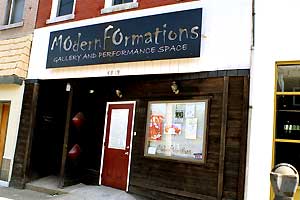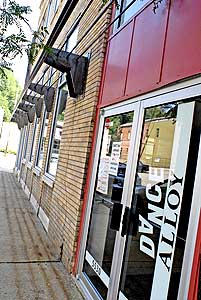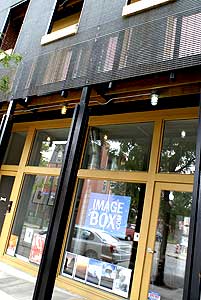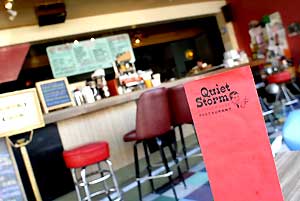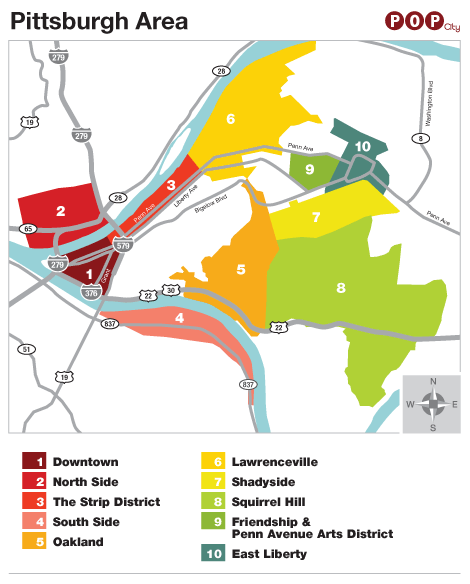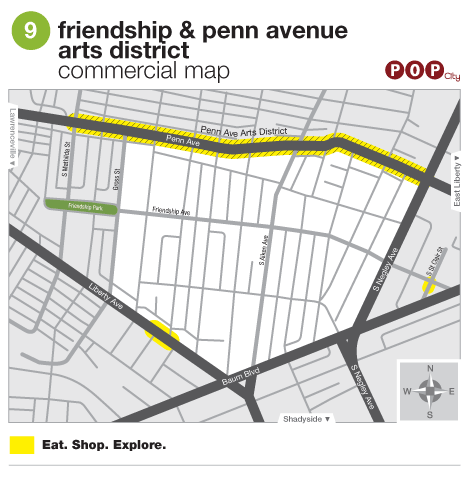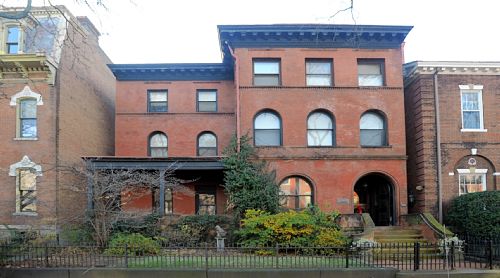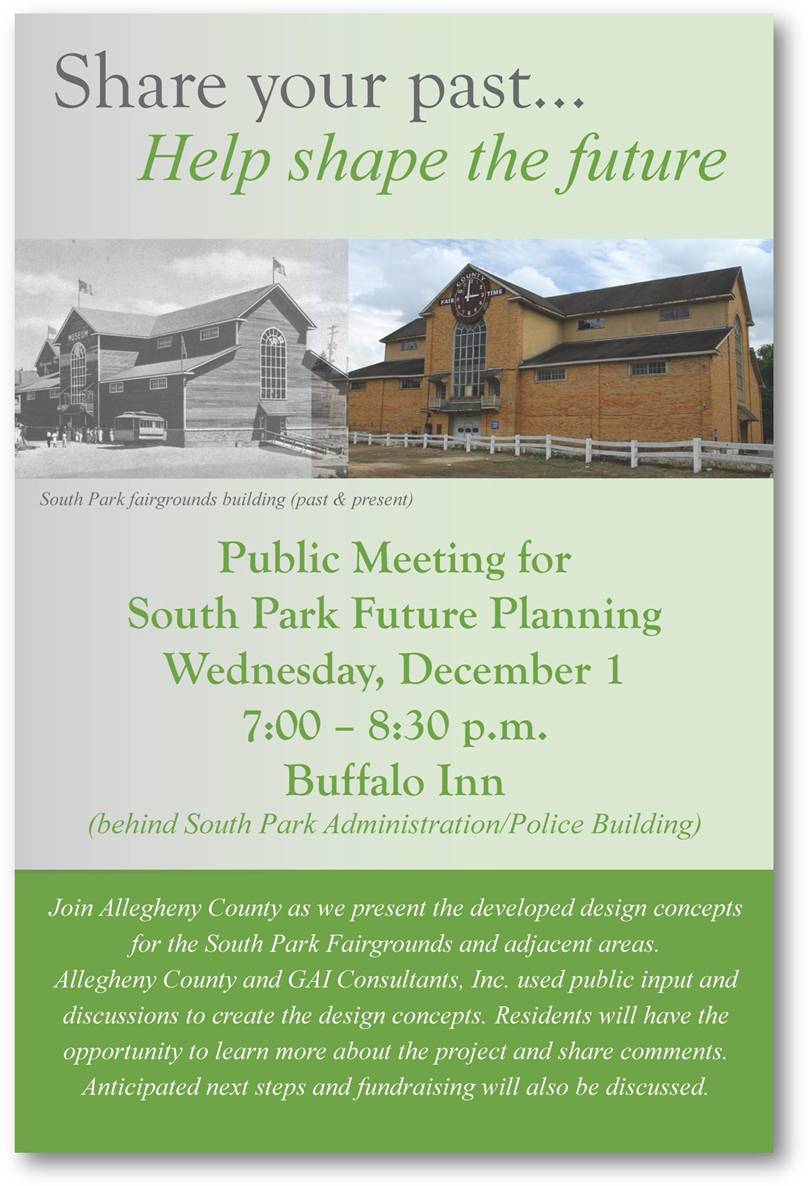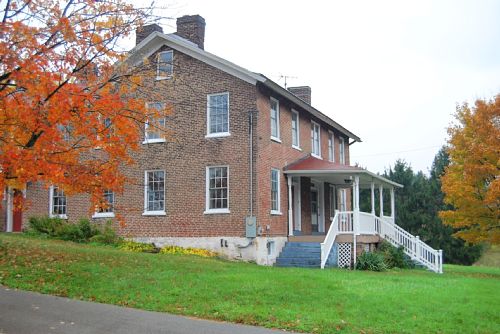
Category Archive: Tours & Events
-
The Visitor’s Guide to Friendship
Pop City MediaKelli McElhinny | Wednesday, September 13, 2006If you haven’t been to Friendship’s northern border of Penn Avenue lately, you’re in for a sweet surprise. The transformation, from a blighted area to a vibrant arts district, is well underway, courtesy of the Penn Avenue Arts Initiative (PAAI), a strategic partnership between the Friendship Development Associates and Bloomfield-Garfield Corporation. Today, many of Pittsburgh’s best-kept secrets, from art to architecture, can be found in Friendship.
The gutsy transformation has been driven by the PAAI, a formidable group which helps artists buy and renovate properties, provides technical assistance to artists, and promotes them as well as the neighborhood. The group even connects artists to local youth and their families through fun events and workshops that benefit all involved.
The liveliest time to visit this vibrant neighborhood is the first Friday of each month, for the PAAI showcase, Unblurred, when the area’s galleries and businesses throw open their doors to host a variety of events, from openings to art workshops. Despite gloomy weather and the threat of rain at the September event, music filled the air and hundreds of people jammed the galleries in the festive gathering on Penn Ave.
Mural Mural on the Wall
As you work your way down the street (Penn Ave, that is) keep on eye on the building walls of Friendship where some of the neighborhood’s most intriguing public art –such as the well-known The Bride Mural—can be found.
The landmark Bridal Mural, designed and created by the late Judy Penzer and Jill Watson, fools the eye by depicting a continuation of the row of buildings next to it. In 2001, “The Gateway,” mural was created by local artists at 5149 and 5150 Penn Avenue to represent the mission of PAAI – bringing the arts on both sides of Penn Avenue together via the street itself. Another notable mural is at 4908 Penn Avenue. Titled “Today’s Heroic Paragon,” it was created by Kevin Fung in 2003 in memory of a resident.
Many of the murals are the product of the Sprout Fund, a much-admired foundation located in Friendship that funds arts and other area projects that enliven the city as well as stimulate economic development by making the region attractive to young people.
The Art of Dance. And Foursquare.
The eastern end of Penn Avenue in Friendship is home to Attack Theater, one of Pittsburgh’s most innovative performing arts groups. In studio space at the corner of Penn and Mathilda, the dance troupe holds occasional informal performances in addition to offering modern dance classes to the community on Tuesdays. Unblurred attendees wanting to nurture their inner child can stop by for Game Night, to play foursquare, 3D tic-tac-toe, and Connect Four, and enjoy intermittent performances.
Further along Penn Avenue, you’ll find a group of modest galleries where hipsters – with a few adventurous suburbanites mixed in – spill out onto the sidewalk. Visitors to Modern Formations can settle into one of the comfy couches to enjoy a performance by local musicians, or peruse the pieces by Pittsburgh artists that grace the gallery’s purple walls.
Next up is Garfield Artworks, which shows local, regional and national artists, features a 100-foot-deep floor plan that lends itself to a multitude of uses, from performances to poetry readings to private parties.
At this point in the trip down Penn, a quick detour down Winebiddle Street is worthwhile to see the Waldorf School of Pittsburgh, located in one of the neighborhood’s oldest and most beautiful buildings. Originally a private residence that was converted into a convent for sisters of the Ursuline order, the building now houses the private K-8 school that moved to Friendship from the South Side in 2003. This historic landmark still hosts private events, in addition to its everyday function.
Back on Penn Avenue, head for the Clay Penn, with its storefront graced with thousands of mosaic tiles, many designed by Unblurred participants in a workshop. Owner and artist Laura Jean McLaughlin showcases her own work in the first-floor space, along with exhibitions by other artists. Soon, community classes and workshops will be offered here, too.
Next stop? Studio 5013 where, at any time, you can view a window display of one of many local artists since it’s illuminated for nighttime browsing. Behind the gallery curtain, artist Laura Shaffalo has done a tremendous job restoring the building’s splendor in creating her own live/work space, refinishing the building’s original pine floors and preserving architectural features such as the French doors.
There’s still room for improvement but The Penn Avenue Arts District continues to blossom and grow with each passing month. Since July, Penn Avenue has seen the opening of four additional galleries: IMAGEBOX at 4933 Penn Avenue, < c > space at 4823 Penn, ON Gallery at 5005 Penn and 5151 Penn Gallery.
At < c > space, a live band entertained a throng of visitors during its opening event September 1st. Guests were treated to art and music on the first floor, along with an appetizing spread of food and drinks, while upstairs the hip, renovated living quarters were open for viewing.
On September 14th, ON Gallery plays host to noted author, Mary Gaitskill, in a Pittsburgh Arts & Lectures event.
Wine and dine
Hungry? You’re in a great spot for some of the city’s best offerings in ethnic fare. Although the selection is small, the cuisine is top-notch. The locals swear by the curry at People’s Indian Restaurant, and Pho Minh is one of Pittsburgh’s few spots for authentic Vietnamese. Those with less exotic tastes can grab a slice with just the right amount of grease without parting with too much dough at Vince’s Pizza or Calabria’s.
A little farther up the street, past two institutions found in nearly every urban neighborhood – the dollar store and the funeral home – lies one of Penn Avenue’s most eclectic spots, the Quiet Storm. Complete with a vegan-friendly menu, an abundance of toys for folks under 10 (and ample space in which to play with them), and a magazine selection that puts the corner newsstand to shame, this nuisance bar-turned-coffeehouse draws in a mélange of characters from all over the city, whether a family stopping in for Sunday brunch or a doctoral student hunkering down to work on his thesis. The menu alone makes the Quiet Storm a must to visit, but those who need extra motivation might find it in the live performances hosted by the coffeehouse on Friday and Saturday nights.
Another option within walking distance is Silky’s Pub, a cozy Liberty Avenue bar that gives patrons the opportunity to brush up on their shuffleboard skills while sipping a beverage. At the end of Friendship Avenue, the popular Sharp Edge features such an extensive collection of Belgian beers that the owner has been knighted in Belgium.
Across the street from the Quiet Storm is the highly regarded EDGE studio, a cutting-edge architecture firm that regularly brings artists of international stature regularly into their gallery.
Reaching the eastern end of Penn Avenue, you’ll find one of the nation’s best glass facilities, and possibly in a class by itself, the Pittsburgh Glass Center. Housing large studios in space that formerly served as a car showroom, PGC is known across the country for the quality of art it produces–American Style magazine recently noted that it put Pittsburgh on the map for glass– and the community is encouraged to participate in the process. The facilities are impressive: eight glory-holes, a flame-working and a cold-working studio, natural gas and propane hand-torches and a roomy gallery to display the stunning glass work creations. A variety of classes you won’t find elsewhere are offered by masters in their art form, from glassblowing to bead making, and participants of all skill levels can find a course that fits their experience.
More classes of a different variety can be found just down the street from the PGC. The Neighborhood Dance Center, home to Dance Alloy Theater, provides space for one of the region’s most comprehensive community dance and fitness programs as well as their own professional modern dance company. Courses grouped by age allow a range of participants from toddlers to grandmas to enjoy activities from ballet to tango to Pilates. There’s no better place in Pittsburgh to get moving – and meet new friends. The company performs on a biannual home season with smaller showings throughout the year.
How to get there
What’s the best way is to get to this evolving neighborhood? Public transportation choices are plentiful. Eight PAT routes travel through one of Friendship’s main thoroughfares. If you choose to come by car, street parking is almost always available as well, if not on Penn, then no more than two blocks away on one of the cross streets.
Here are the main PAT routes to get you around the neighborhood.
Baum Boulevard: 77A, 77B
Centre Avenue to Downtown: 71A via Oakland, 81B via the Hill District and 86A via Bloomfield and the Strip District
Friendship Avenue to Downtown and East End destinations (such as Highland Park, the Pittsburgh Zoo and Morningside): 77D, 77F and 77GPenn Avenue: 86B to the Strip District and Downtown, 89A to the East Liberty shopping district and Martin Luther King, Jr. East Busway
Routes 77A, 77B, 81B, 86A and 86B also serve East Liberty shopping areas.While the first Friday of the month is when Friendship is showcased at its finest, anytime is a good time to visit this up and coming neighborhood.
-
Allegheny West’s Annual Holiday House Tour Shows Off Style, Taste and City History
Saturday, December 04, 2010By Patricia Lowry, Pittsburgh Post-GazetteOn Thanksgiving eve, when I called Alex Watson about previewing his house for next weekend’s Allegheny West Victorian Christmas House Tour, I assumed it would be too early to see it in holiday garb.
“Oh, that won’t be a problem,” he said. “My Christmas tree has been up for three years.”
When your house has been on the tour for 28 of the event’s 29 years, leaving the artificial tree up and decorated in a corner of the library seems the expedient thing to do.
Next to it, on the mantel, stands the illuminated Dickens Christmas village Mr. Watson made decades ago of fiberboard, crowned by London’s St. Paul Cathedral and complete with Scrooge & Marley’s counting house. It’s now a year-round feature, too.
And next to that, on the wainscot ledge, stand a dozen smaller buildings closer to home, representing Allegheny West houses that have appeared on neighborhood tours. He and his neighbors made those, too, for sale to tour-goers in years past.
Anything to support his beloved Allegheny West, the North Side neighborhood in which he and his late partner, Merle Dickinson, settled in 1960, when they purchased the North Lincoln Avenue home. Then broken into 17 (now 10) apartments, it was far from the showplace it is today.
The red brick house, originally a two-story built between 1864 and 1865, was enlarged to its present three-story size and Romanesque Revival appearance in the early 1890s, when a library also was added to the front of the house.
Grain merchant John W. Simpson was the original owner; Joseph Walton bought it in 1888 for daughter Ida Walton Scully and her husband, glass manufacturer James Scully. In 1917 the house was sold to James S. Childs, a shoe, rubber and leather wholesaler whose wife Alice was Ida Scully’s sister.
In 1923 the house changed hands again; the new owners were Samuel and Margaret Crow, who lived there and rented rooms to boarders. The house stayed in the Crow family until 1960.
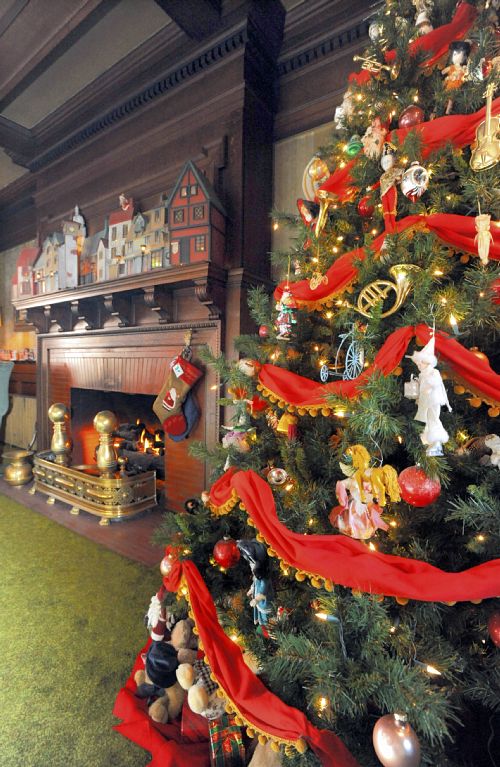
The library in Alex Watson's North Lincoln St. home is decorated for the holidays. Bob Donaldson / Post-Gazette
The house’s architect is unknown; none surfaced during architectural historian Carol Peterson’s extensive house history research. Mr. Watson thinks it may have been Longfellow, Alden and Harlow, who in 1889 completed a house across the street commissioned by B. F. Jones for his daughter Elizabeth and her husband, Joseph O. Horne, son of the department store founder. It’s a good bet, considering the richly carved and paneled oak interior finishes, the melding of medieval and classical influences and a first-floor layout similar to the Horne house. The firm designed 13 buildings within a radius of several blocks and Frank Alden had lived just around the corner.
Restoring the home’s original features became a decades-long passion for Mr. Watson and Mr. Dickinson, who did much of the work themselves. And there was much work to do. While most of the interior woodwork remained, the first floor’s front parlor, library and dining room had been its own apartment with kitchen and bath.
One bathroom occupied a corner of the entrance hall; during its removal, the owners discovered a long-lost corner of the hall’s original mantel. From that remnant, they re-created the mantel and over-mantel and warmed up the room with a gas fireplace.
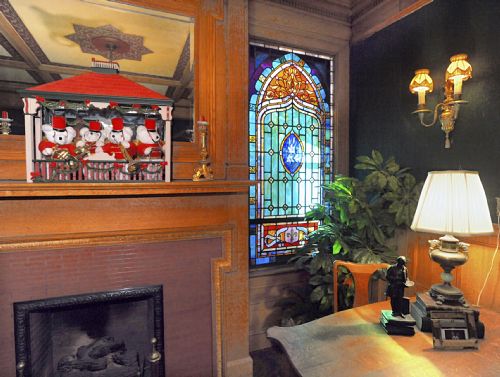
The hallway in Alex Watson's North Lincoln St. home is decorated for the holidays. Bob Donaldson / Post-Gazette
Mr. Watson has his regrets, including removal of a mantel and overmantel in the front parlor to gain wall space. They recycled it as a bar and back bar in the former kitchen, now a game room outfitted as a bordello dedicated to 1920s neighborhood madam Nettie Gordon. Eventually, in atonement, they purchased a white marble Italianate mantel from a Sewickley house sale for the front parlor.
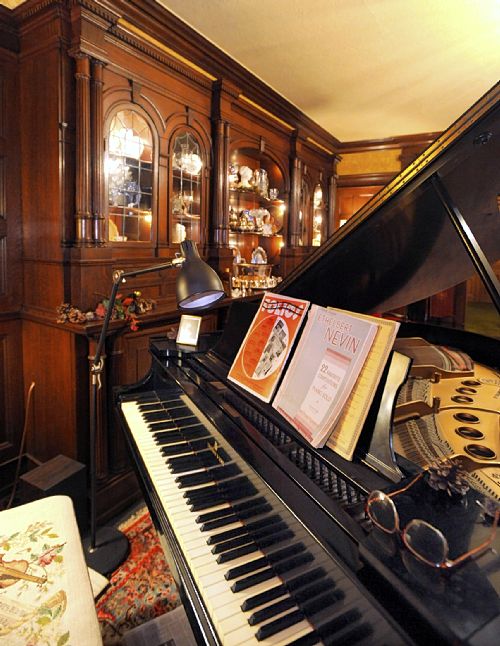
The music room in Alex Watson's North Lincoln St. home. Originally the home's dining room, the breakfront still dominates the room. The home will be on the Allegheny West Christmas House Tour. Bob Donaldson / Post-Gazette
In the former dining room, now the music room, Mr. Watson (on the piano) and friend Mark Schumacher (on the organ) plan to greet tour-goers, as they have in years past, with songs of the season. Seeing the faces of visitors as they enter the room, Mr. Watson said, “makes the whole thing worthwhile.”
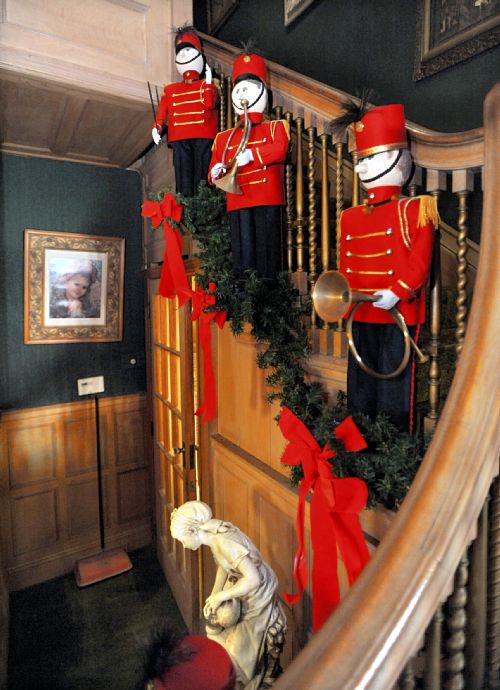
The hallway in Alex Watson's North Lincoln St. home is decorated for the holidays. Bob Donaldson / Post-Gazette
Trained in nursery and landscape management at Michigan State, Mr. Watson managed the garden shop at Sears for 27 years before it became part of Allegheny Center. His courtyard garden, glimpsed through the oak-paneled music room windows, has been featured on neighborhood garden tours; this time tour-goers will pass through it as they leave.
The six houses on the tour, spread over three blocks, include Gretchen Duthoy’s red brick, Second Empire-style Beech Avenue home, a newbie to the event.
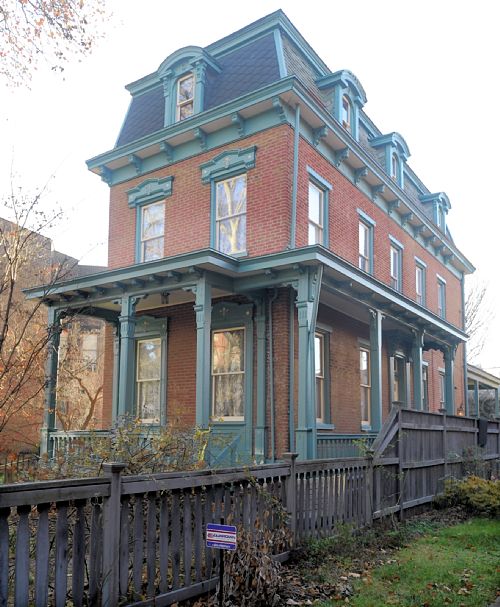
This home at 849 Beech Ave. will be on the Allegheny West Christmas House Tour. Bob Donaldson / Post-Gazette
“My house was turning 150 this year,” said Ms. Duthoy, who wanted to do something to mark the occasion. She commissioned a house history from Ms. Peterson, who discovered the house in fact was 140 years old, having been built in 1870 for railroad conductor Theodore Gray and his wife Annie. The longest ownership — 1887 to 1922 — came with four generations of the family of Christian Stoner, partner in a Strip District lumber mill.
When Ms. Duthoy, an Alcoa employee who grew up in suburban Maryland, bought the house in 2003, it had been restored by its previous owners, for whom she’d worked as a baby sitter in college.
“That’s how I came to know the house and the neighborhood and that’s how I came to live there” a few years later when they had outgrown it, she said.
Her work on the house has been cosmetic, including a kitchen update. For the tour she’ll hang family ornaments on her live tree and decorate extensively with fresh greens.
The tour, she said, is “a great showcase for the neighborhood, and I’d like to do my part.”
Allegheny West Victorian Christmas House TourInformation: Guided walking tours cost $25 per person and leave from Calvary United Methodist Church, Allegheny and Beech avenues, at 12-minute intervals from 5 to 8 p.m. Friday, and 10 a.m. to 8 p.m. next Saturday, with a maximum of 25 guests per tour. Tour guides will talk about 19th-century holiday traditions and the history of the neighborhood and the homes on the tour.
At the end of the event, which lasts about three hours, tour-goers can visit John DeSantis’ miniature railroad village and toy train collection at Holmes Hall, 719 Brighton Road, for an additional $10, as well as the Holiday Shoppe at Jones Hall, with antiques, gifts and handcrafted items. Mr. DeSantis’ train collection, open to the public only during the Christmas tour, also can be visited separately; hours are 7:30 to 10 p.m. Friday and 12:30 to 10 p.m. Saturday.
Special tours include a wine tour at 6 p.m. Friday, with wine tasting and hors d’oeuvres at a private residence, followed by the house tour ($75 per person). On Saturday, brunch tours will be offered at 10 and 10:30 a.m. and high-tea tours at 3 and 3:30 p.m. ($50 per person), followed by the house tour. With help from The Center for Hearing and Deaf Services, a signed tour will be offered at 3:36 p.m. Saturday ($25 per person).
Tours are rain or shine, snow, sleet or hail. As the Allegheny West Civic Council’s website puts it, “This is Pittsburgh and bad weather is part of the charm.” Reservations are required for all tours and tickets are nonrefundable. Visit the website (alleghenywest.org) or call 412-323-8884.
-
Rachel Carson Homestead Association Board of Directors Opens Search for New Executive Director
December 2, 2010
PRESS RELEASE:
Contact:
Bill Schillinger 724-321-7915bill@rachelcarsonhomestead.org
New Era Begins for Regional Environmental Organization
SPRINGDALE, PA – (Dec. 2, 2010) – The Board of Directors of the Rachel Carson Homestead Association, a regional organization dedicated to the principles of greater environmental awareness and action promoted by its namesake, announced today the opening of a search for a new executive director.
Following a thorough strategic planning process, the not-for-profit organization has embarked on a program to restore and transform the childhood home of Rachel Carson in Springdale, Pennsylvania, just north of Pittsburgh, into a center for information and ideas on a healthy environment. Coordinating a capital campaign in support of this transformation will be a major responsibility of the new executive director.
The Association takes it inspiration from Carson, a professional marine biologist who achieved international fame in 1962 for her groundbreaking book, “Silent Spring,” which discussed the potential hazards of synthetic pesticides. The Association plans a series of special events to commemorate the 50th anniversary of “Silent Spring” in 2012.
“Rachel Carson stood for strong principles like integrity, open dialogue, and fostering a positive exchange of ideas concerning the environment,” said William Schillinger, chairman of the Rachel Carson Homestead Association board. “Our organization stands for those same principles. With the start of our search for a new executive director, we intend to increase efforts to make the Homestead a destination site. It is the primary focus of our group’s mission.”
The executive director will be responsible for the day-to-day administration of the organization,along with fund-raising and
other publicly-oriented activities. The search follows the departure of Patricia DeMarco, PhD., who, as executive director of the Homestead Association for the past five years, has been instrumental in growing its programs.“As we move forward, we are ready to engage new leadership that will manage the Capital Campaign and events surrounding the Homestead’s renewal in 2012,” said Schillinger. “Much like the impressive span over the Allegheny River that bears Rachel Carson’s name, we will continue to build strong bridges focused on active, respectful, dialogue about the challenging environmental issues of our day.” he said.
-
Welcoming Vandergrift has Plenty of Special Features
By Bob Karlovits, PITTSBURGH TRIBUNE-REVIEW
Monday, November 22, 2010Many small towns have rich stories, but few tell them as well as Vandergrift.
Part of that tale is in the layout of the historic area of the 115-year-old town. Designed by the firm of Frederick Law Olmsted, the creator of New York City’s Central Park and many academic campuses, the streets arch over and around the hillside on which the town is built.
A grand theater, the Casino, sits facing a mall leading down to a train station. It was given that spot intentionally to offer a welcome to anyone arriving in the Westmoreland County town.
The town was built to provide a home for workers at the steel mill of George McMurtry. The mill has had six owners since its first, but still is working, despite the decline of the steel industry.
All of those features make Vandergrift a place where the past is a major part of the present. It makes it worth a visit to see that story.
1:30 p.m.
The Victorian Vandergrift Museum is in a school built in 1911 and, like many features of the town, is a work in progress.
With displays on three floors, it tells the story of the town in a number of ways. On the bottom floor is a room decorated with many pictures of initial work on the town along with map of the plans originated by the Olmsted firm.
If you’re lucky, you might run into Bill Hesketh, treasurer of the museum and historical society. He could tell you about McMurtry, owner of Apollo Iron & Steel, wanting to build a town that would attract workers and entice them to stay.
He would do that by having the famed designers draw up a plan for the ultimate company town. McMurtry thought a cultured worker was a good worker, so included plans for the Casino. He also saw the benefit of religious life, so provided $7,500 to any congregation planning to build a church costing $15,000 or more. He wanted sober workers, so the town was dry until 1936.
If you are lucky, Hesketh will be there to offer you some thoughts. But it will take some luck. He does not schedule tours or times he is there for visits. There are no other guides at the museum either. But simply wandering around the museum will provide a look at what Vandergrift is all about.
Victorian Vandergrift Museum, 184 Sherman Ave. Hours: 10 a.m. to 3 p.m. Mondays to Saturdays. Details: 724-568-1990.
3 p.m.
Now, it’s time to take to the streets. In some ways, the rows of houses are the story of Vandergrift.
The look of the town is somewhat defined by the rows of company homes on streets that are devoid of 90-degree angles.
When the Olmsted designers laid out the plan, Hesketh says, they decided on 50-feet-wide lots, but McMurtry thought that was way too wide. He was selling the lots, and wanted to profit from them.
They became 25-feet-wide, leading to streets of homes generally built tightly together.
Hesketh points out some people eventually bought two homes and built them together to make one bigger residence. Or they bought one and tore it down to create a bigger yard. There are some properties that were sold as 50-feet-wide and are the sites of some nicer homes, for the non-laborer class.
Take a walk around and look at the history of a town as seen in its homes. The look of the town is created by the past and the gentle curves of the Olmsted design, which even creates a non-straight business district.
5:30 p.m.
After touring Vandergrift and getting ready for the finale of this day, it is time for dinner.
There are some likely stops for a meal in town, and these three win local praise. You probably saw them as you wandered around.
The G&G Restaurant (724-567-6139) on Columbia Avenue is largely a breakfast and lunch place, but is open till 9 p.m. for dinner.
A.J.’s Restaurant (724-568-2464) is open Tuesdays, Wednesdays, Thursdays and Saturdays until 10 p.m. and 11 p.m. Fridays.
Offering a more specific dinner outlook is the Steeltown Smokehouse (724-568-4087) on Washington Avenue. The burgers-and-wings emporium is open till 8 p.m. Mondays to Thursday, 9 p.m. Fridays and Saturdays and 6 p.m. Sundays.
7 p.m.
The best way to do this trip is to pay attention to the shows at the Casino, which can be checked out at www.casinotheater.org, then plan a visit on a day ending with some entertainment.
Make sure to arrive at the Casino with enough time to look around.
The oldest, active theater in Western Pennsylvania had become a unused shell when a group that became Casino Theatre & Restoration Management took it over in 1991, Hesketh says. They brought the site back to life.
Trumpet star Maynard Ferguson (1928-2006) performed there along with the Vogues and the Clarks. The renovated theater has been the home of stage presentations. Some of the restoration meant changes from the original, Hesketh says, but some of that provided aspects that seemed to be needed.
“This place just called for boxes,” he says, pointing to box seats on each side of the stage.
Roam around the Casino. The balcony casts a good and attractive view of the stage. The lobby, slightly smaller than what it once was, offers an attractive entrance.
McMurtry thought the Casino would be a significant part of the town when it was built in 1900.
It still is.
-
Public Meeting for South Park Future Planning
-
Unusual Touches Mark Phipps’ Winter Show
Saturday, November 20, 2010The Winter Flower Show opens Friday at Phipps Conservatory and Botanical Gardens in Oakland. Nine of the indoor gardens will be bedecked with topiary snowmen, decorated trees, hanging baskets, thousands of lights and more than 2,000 poinsettias. Newer varieties of poinsettias will be on display, including ‘Polar Bear,’ ‘Winter Blush,’ ‘Ice Punch,’ ‘Visions of Grandeur’ and ‘Tapestry.’
Also on display is the garden railroad with operating trains and miniature living scenery that includes dwarf conifers. The show, which runs through Jan. 9, was designed by the conservatory staff with help from Michele McCann.
“The show is a wonderful combination of horticulture and whimsy, with beautiful new poinsettias and common annuals used in unusual ways,” says Margie Radebaugh, Phipps’ director of horticulture and education.
Special seasonal events include:
• Visits by Santa Claus on Saturdays and Sundays through Dec. 19.
• A “Garlands & Gifts” sale on Dec. 2-3 from 10 a.m. until 7 p.m.
• Phipps stays open until 10 p.m. daily, beginning Dec. 6, with candlelit walkways and live entertainment.
Admission is $12 for adults; $11 for seniors 62 and older and students with valid ID; $9 for children ages 2 to 18; free for children under 2. Information: www.phippsconservatory.org or 412-622-6914.
-
Woodville Plantation Offers Holiday Tours by Candlelight
Thursday, November 18, 2010Pittsburgh Post-GazetteThe Woodville Plantation living history museum will celebrate the holiday season in an 18th-century fashion with candlelight tours from noon to 8 p.m. Sunday at the historic site, 1375 Washington Pike, Collier.
Admission is $5 for adults and $3 for children ages 6-12.
The event will feature costumed guides, holiday displays and traditional decorations. Visitors will learn about holiday customs such as Twelfth Night, Boxing Day and the firing of the Christmas guns.
The full table feast celebrated during Twelfth Night will be displayed, and visitors will hear students of The Pittsburgh Music Academy perform musical selections throughout the day on a circa 1815 pianoforte.
A piece of Whiskey Rebellion history will be displayed — a flag that was once used by the whiskey rebels as a symbol of their resistance to the 1791 excise tax on whiskey.
The flag, owned by historian Claude Harkins and on loan to the Neville House Associates, is thought to be one of only two documented flags from the Whiskey Rebellion Insurrection of 1794.
Woodville Plantation, the home of John and Presley Neville, was built in 1775. It interprets life during the period of 1780-1820, the era of the New Republic. Guided tours of the house are available every Sunday from 1 to 4 p.m.
-
Abel Colley Tavern Helps Preserve Fayette County History
Sunday, November 14, 2010By Marylynne Pitz, Pittsburgh Post-GazetteUNIONTOWN — Five miles west of this Fayette County seat stands the Abel Colley Tavern, a red-brick beacon of hospitality to travelers along the National Road during the 1800s.
Just one mile from Searight’s Toll House, the tavern was known for its moderate prices and hearty clientele of wagoners, who swapped many a tale over Monongahela Rye in its barroom.
By this time next year, it will be a place for even more stories as it becomes the Fayette County Museum. With 6,500 square feet, the restored building will have office space on the second floor for the Fayette County Historical Society, which currently has no regular space to meet; its members often house artifacts in their homes.
The last people to live there, Sue and Frank Dulik, left the property to Virginia and Warren Dick, who donated it to the society.

Jeremy S. Burnworth, president of the Fayette County Historical Society, stands inside the front door of the former Abel Colley Tavern, which has been restored and will become the society's new home next year. Marylynne Pitz
Jeremy S. Burnworth, the society’s 31-year-old president, is a Markleysburg native who has developed a passion for Fayette County’s rich history. At a convention in September of the American Association of State and Local History, Mr. Burnworth got excited when he learned about standardized software made by the Rescarta Foundation in Wisconsin that allows historical societies to photograph, log and archive materials.
“What a perfect opportunity to do it right from day one,” he said.
An advisory committee will oversee the museum’s operation and at least 30 people have volunteered to help staff the museum and toll house. One of Fayette County’s best-known residents has also pitched in. At an opening ceremony in July, the temperature rose to 99 degrees in the 19th-century building. Joe Hardy, the 84 Lumber tycoon and former Fayette County commissioner, offered afterward to pay for a new heating and cooling system.
One person who knows the building well is Tom Buckelew, a retired physiology professor from California University of Pennsylvania. He figures he has spent 1,500 hours working on restoring the former tavern.
“It had been modernized with drop ceilings and acoustic tile ceilings,” Mr. Buckelew said, adding that many of the rooms had four or five layers of wallpaper that had to be stripped before repainting with period-appropriate colors.
Just inside the front door is a large foyer with a staircase. On the ceiling is some of Mr. Buckelew’s best craftsmanship — a hand-carved ceiling medallion that lends elegance to the new chandelier.
“I roughed out the medallion with a band saw and then just carved the rest. That was about two weeks, three hours a day,” he said.
On the second floor is a large ballroom where Mr. Buckelew painted an intricate, ruglike pattern of mustard, brick red and chocolate brown. It’s actually a centuries-old trick for disguising uneven floors.
“It was a way of capitalizing on bad design,” he said, adding that the front part of the ballroom is probably an inch lower than the back portion. “That was a feature that a lot of people adopted in the early 19th century. In lieu of rugs, you paint a rug on the floor.”
A team of inmates from SCI-Greene spent two weeks hanging dry wall in the building. A new ceiling was attached to a plaster-and-lathe one in the second-floor ballroom. Then, Mr. Buckelew put up crown molding with the help of another volunteer, Bill Zin. Joe Petrucci, a township supervisor in Menallen, donated 400 board feet of molding.
“That ceiling is tied to irregular joists. So the ceiling naturally has some dips in it, high spots and low spots,” Mr. Buckelew said, adding that the crown molding camouflages the dips.
The building, done in a vernacular Greek Revival style, was added to the National Register of Historic Places in 1995. Jerry Clouse, who nominated the building for federal designation, dates the structure to around 1835. He said two architectural features signify its use as a tavern: the kitchen ell with a double-stacked porch and two front doors, one of which opens into the barroom.
At least one historian believes it may have been a home much longer than it was a tavern. Ronald L. Michael, a retired anthropologist who excavated around the nearby Peter Colley Tavern in 1973, believes Abel Colley’s famous tavern stood on the opposite side of Route 40, partly because there was once a well on that property which would have provided water for travelers and horses.
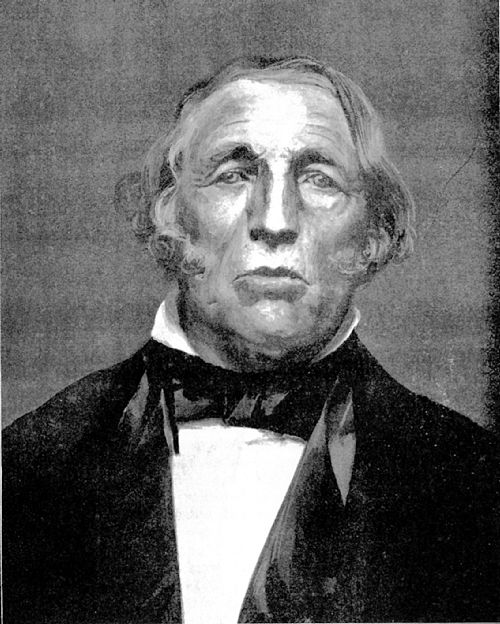
Abel Colley owned a Fayette County tavern just outside of Uniontown on U.S. Route 40. Volunteers have restored the 19th-century building during the past year. The former tavern will become the Fayette County Museum next year and also will provide office space for the Fayette County Historical Society.
The building that locals know as the Abel Colley Tavern, Dr. Michael said, is more likely the house he built after making his fortune in the hospitality business, then retiring. Mr. Burnworth agrees but still treasures its history.
“It was probably only a tavern, if ever, for a very short period of time,” he said. “He died a few years after we believe it was built. Most likely, it was his home.”



